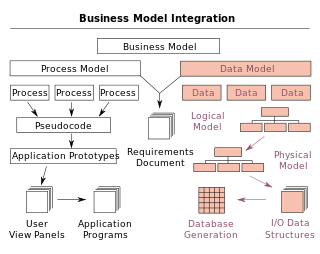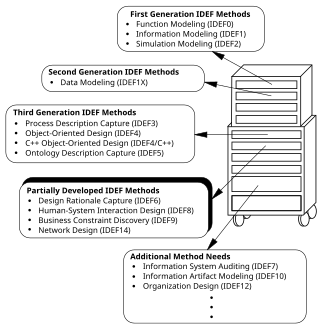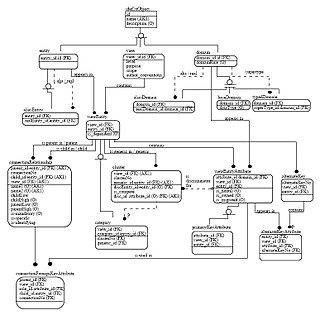Related Research Articles

An object database or object-oriented database is a database management system in which information is represented in the form of objects as used in object-oriented programming. Object databases are different from relational databases which are table-oriented. A third type, object–relational databases, is a hybrid of both approaches. Object databases have been considered since the early 1980s.
Object–relational mapping in computer science is a programming technique for converting data between a relational database and the memory of an object-oriented programming language. This creates, in effect, a virtual object database that can be used from within the programming language.
The Enterprise Objects Framework, or simply EOF, was introduced by NeXT in 1994 as a pioneering object-relational mapping product for its NeXTSTEP and OpenStep development platforms. EOF abstracts the process of interacting with a relational database by mapping database rows to Java or Objective-C objects. This largely relieves developers from writing low-level SQL code.

An object–relational database (ORD), or object–relational database management system (ORDBMS), is a database management system (DBMS) similar to a relational database, but with an object-oriented database model: objects, classes and inheritance are directly supported in database schemas and in the query language. Also, as with pure relational systems, it supports extension of the data model with custom data types and methods.

A data model is an abstract model that organizes elements of data and standardizes how they relate to one another and to the properties of real-world entities. For instance, a data model may specify that the data element representing a car be composed of a number of other elements which, in turn, represent the color and size of the car and define its owner.
Software design pattern refers to a reusable, proven solution to a specific, recurring problem typically focused on component-level design, though they can sometimes span multiple components. Design patterns address specific issues related to object creation, interaction, or behavior.
An object-oriented operating system is an operating system that is designed, structured, and operated using object-oriented programming principles.

Model–view–controller (MVC) is a software design pattern commonly used for developing user interfaces that divides the related program logic into three interconnected elements. These elements are:

IDEF, initially an abbreviation of ICAM Definition and renamed in 1999 as Integration Definition, is a family of modeling languages in the field of systems and software engineering. They cover a wide range of uses from functional modeling to data, simulation, object-oriented analysis and design, and knowledge acquisition. These definition languages were developed under funding from U.S. Air Force and, although still most commonly used by them and other military and United States Department of Defense (DoD) agencies, are in the public domain.
Hibernate ORM is an object–relational mapping tool for the Java programming language. It provides a framework for mapping an object-oriented domain model to a relational database. Hibernate handles object–relational impedance mismatch problems by replacing direct, persistent database accesses with high-level object handling functions.

An information model in software engineering is a representation of concepts and the relationships, constraints, rules, and operations to specify data semantics for a chosen domain of discourse. Typically it specifies relations between kinds of things, but may also include relations with individual things. It can provide sharable, stable, and organized structure of information requirements or knowledge for the domain context.
Object–relational impedance mismatch is a set of difficulties going between data in relational data stores and data in domain-driven object models. Relational Database Management Systems (RDBMS) is the standard method for storing data in a dedicated database, while object-oriented (OO) programming is the default method for business-centric design in programming languages. The problem lies in neither relational databases nor OO programming, but in the conceptual difficulty mapping between the two logic models. Both logical models are differently implementable using database servers, programming languages, design patterns, or other technologies. Issues range from application to enterprise scale, whenever stored relational data is used in domain-driven object models, and vice versa. Object-oriented data stores can trade this problem for other implementation difficulties.
The Shlaer–Mellor method, also known as object-oriented systems analysis (OOSA) or object-oriented analysis (OOA) is an object-oriented software development methodology introduced by Sally Shlaer and Stephen Mellor in 1988. The method makes the documented analysis so precise that it is possible to implement the analysis model directly by translation to the target architecture, rather than by elaborating model changes through a series of more platform-specific models. In the new millennium the Shlaer–Mellor method has migrated to the UML notation, becoming Executable UML.
Object-oriented analysis and design (OOAD) is a technical approach for analyzing and designing an application, system, or business by applying object-oriented programming, as well as using visual modeling throughout the software development process to guide stakeholder communication and product quality.
In computer programming, glue code is code that allows components to interoperate that otherwise are incompatible. The adapter pattern describes glue code as a software design pattern.

Object-oriented programming (OOP) is a programming paradigm based on the concept of objects, which can contain data and code: data in the form of fields, and code in the form of procedures. In OOP, computer programs are designed by making them out of objects that interact with one another.
UML is a modeling language used by software developers. UML can be used to develop diagrams and provide users (programmers) with ready-to-use, expressive modeling examples. Some UML tools generate program language code from UML. UML can be used for modeling a system independent of a platform language. UML is a graphical language for visualizing, specifying, constructing, and documenting information about software-intensive systems. UML gives a standard way to write a system model, covering conceptual ideas. With an understanding of modeling, the use and application of UML can make the software development process more efficient.
Object-PL/SQL is a methodology of using the Oracle Corporation's procedural extension language for SQL and the Oracle relational database. The additional features from version 7 and other improvements, lead to one of the large-scale environment implementations of the object-oriented database paradigm.
The following is provided as an overview of and topical guide to databases:
Oracle TopLink is a mapping and persistence framework for Java developers. TopLink is produced by Oracle and is a part of Oracle's OracleAS, WebLogic, and OC4J servers. It is an object-persistence and object-transformation framework. TopLink provides development tools and run-time functionalities that ease the development process and help increase functionality. Persistent object-oriented data is stored in relational databases which helps build high-performance applications. Storing data in either XML or relational databases is made possible by transforming it from object-oriented data.
References
- ↑ Cesare, Sergio de; Lycett, Mark; Macredie, Bobert. D. (2006). Development of Component-Based Information Systems. Vol. 2 (1st ed.). New York: M. E. Sharp. p. 52. ISBN 0765612488. ISSN 1554-6152.
- ↑ Fröhlich, Peter Hans (2003). Component-Oriented Programming Languages: Why, What, and How (1 ed.). Irvine: University of California. p. 2.
- ↑ Sureau, Denis (27 March 2012). "History of Programming Languages and Their Evolution". Scriptol. Archived from the original on 16 October 2012. Retrieved 29 March 2012.
- ↑ or even a small application or applet
- 1 2 "The Benefits of Modular Programming" (PDF). Netbeans Org. 2007. Archived from the original (PDF) on 12 January 2012. Retrieved 29 March 2012.
- ↑ Piveta, Eduardo Kessler; Zancanella, Luiz Carlos. "Aurélia: Aspect Oriented Programming Using a Reflective Approach" (PDF). IT Department of Santa Maria University. Retrieved 29 March 2012.[ permanent dead link ]
- ↑ "Components: Interfaces and Adapters". Twisted Matrix Labs. Archived from the original on 24 February 2012. Retrieved 29 March 2012.
- ↑ Guthery, Scott (1 December 1989). "Are the Emperor's New Clothes Object Oriented?". Dr. Dobb's Journal. Retrieved 29 March 2012.
- ↑ "Introduction to Java in Oracle Database". Oracle docs. Retrieved 30 March 2012.
- ↑ Hameurlain, Abdelkader. Lecture Notes in Computer Science.
- ↑ Grundy, John; Patel, Rakesh (2000). "Developing Software Components with the UML, Enterprise Java Beans and Aspects" (PDF). Faculty of Information and Communication Technologies of Swinburne Universe of Technology. Archived from the original (PDF) on 16 March 2014. Retrieved 30 March 2012.